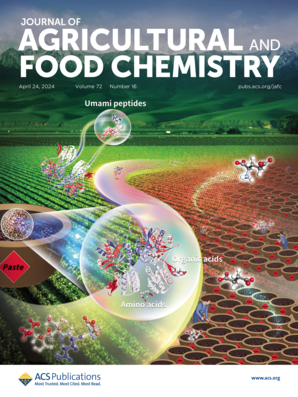从果皮愈合:探索香蕉对胃溃疡管理的生物活性潜力
IF 5.7
1区 农林科学
Q1 AGRICULTURE, MULTIDISCIPLINARY
引用次数: 0
摘要
香蕉(Musaceae)是一种草本植物,广泛种植于热带和亚热带地区,传统上被用于治疗早期胃溃疡。这篇综述提供了香蕉生物活性化合物的综合分析,重点是品种差异和成熟阶段的影响。研究人员已经确定了香蕉中的关键生物活性分子,包括主要位于香蕉皮中的酚类化合物、类胡萝卜素和生物胺。未成熟的香蕉含有较高水平的酚类化合物和生物胺,而成熟的香蕉则含有较多的类胡萝卜素。此外,体内研究表明,黄酮类化合物,特别是白花青素,通过增加胃粘膜厚度和增加表皮生长因子受体的表达,促进胃粘膜血管生成和再上皮化,从而起到胃保护作用,从而防止溃疡的形成。这些发现加强了香蕉的药用价值,特别是在它们未成熟的状态下,并强调了进一步探索其生物活性成分对开发针对胃健康的自然疗法的重要性。本文章由计算机程序翻译,如有差异,请以英文原文为准。

Healing from the Peel: Exploring the Bioactive Potential of Bananas for Gastric Ulcer Management
Bananas (Musaceae), herbaceous plants widely cultivated in tropical and subtropical regions, are traditionally used for their purported therapeutic effects on early-stage gastric ulcers. This comprehensive review provides an analysis of the bioactive compounds in bananas, with a focus on the influence of varietal differences and ripening stages. Researchers have identified key bioactive molecules in bananas, including phenolic compounds, carotenoids, and biogenic amines, predominantly located in the banana peel. Unripe bananas contain higher levels of phenolic compounds and biogenic amines, whereas ripened bananas exhibit increased carotenoid content. Additionally, in vivo studies have indicated that flavonoids, particularly leucocyanidin, exert gastroprotective effects by enhancing gastric mucosal thickness and increasing epidermal growth factor receptor expression, which promotes angiogenesis and re-epithelialization of the gastric mucosa, thereby protecting against ulcer formation. The findings reinforce the medicinal value of bananas, particularly in their unripe state, and highlight the importance of further exploration into their bioactive components for the development of natural therapies targeting gastric health.
求助全文
通过发布文献求助,成功后即可免费获取论文全文。
去求助
来源期刊
CiteScore
9.90
自引率
8.20%
发文量
1375
审稿时长
2.3 months
期刊介绍:
The Journal of Agricultural and Food Chemistry publishes high-quality, cutting edge original research representing complete studies and research advances dealing with the chemistry and biochemistry of agriculture and food. The Journal also encourages papers with chemistry and/or biochemistry as a major component combined with biological/sensory/nutritional/toxicological evaluation related to agriculture and/or food.

 求助内容:
求助内容: 应助结果提醒方式:
应助结果提醒方式:


